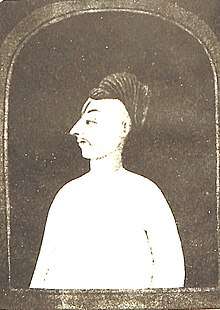Dayaram
Dayaram (Gujarati:દયારામ) (1777–1853) was a Gujarati poet of medieval Gujarati literature and was the last poet of the old Gujarati school. He is known in Gujarati literature for his literary form called Garbi, a lyric songs.[1] He was a follower of Pushtimarg of Hindu Vaishnavism.[2] Dayaram, along with Narsinh Mehta and Meera, is considered a major contributor during the Bhakti movement in Gujarati literature.

Life
Dayaram was born on 16 August 1777 in Chanod on the bank of Narmada river. He was the second son of Prabhuram Pandya, a Sathodara Nagar Brahmin. His siblings, elder sister Dahigauri and younger brother Manishankar, died at the age of nine and two respectively.[2]
His father was a clerk. He had very little education and he was interested in devotional songs of Vaishnava temple. He married in his childhood but his first wife died after two years of marriage. His second marriage did not accompanied as his father died when he was twelve years old. His mother too died two years later. He resided with his relatives in Chanod and Dabhoi. He traveled across India on a pilgrimage of religious places associated with Vaishnavism. His contact with Ichchharam Bhatt turned him to his religious interest.[2]
He was initiated into Pushtimarg (Bhrahmasambandha) in Vikram Samvat 1858 by Vallabhaji Maharaj and was fully initiated in Vikram Samvat in 1861.[2]
Contribution
Dayaram was the last poet of the old Gujarati school. Most of his works are written in literary form called 'Garbi', a lyric songs.[3]
Dayaram was a devotional poet and was a follower of "Nirgun bhakti sampraday" (Pushti sampraday) in Gujarat. So he gave many Garbi describing Krishna -. He used many literary poetic forms to express his devotion. He also wrote long narrative poems based on the incidents on the Mahabharata such as Rukmani Vivah (Marriage of Rukmini), Satyabhama Vivah (Marriage of Satyabhama), Ajamilakhyana (Story of Ajamila), Okhaharan (abduction of Aniruddha by Chitralekha).[4]
Further reading
- Subhasha M. Dave (1970). દયારામ: એક અધ્યયન [Dayaram: A Study]. Anaḍā Buka Ḍīpo.
References
- Rachel Dwyer (2001). The Poetics of Devotion: The Gujarati Lyrics of Dayaram. Psychology Press. p. 1. ISBN 978-0-7007-1233-5.
- Parikh, Dhiru (1995). Dayaram Na Shreshtha Kavyo. Navbharat Sahitya Mandir Ahmedabad. pp. 3–6. OCLC 701053427.
- Joseph T. Shipley, ed. (1946). Encyclopedia of Literature. New York: Philosophical Library. p. 513 https://www.questia.com/read/76778484/encyclopedia-of-literature – via Questia. Missing or empty
|title=(help) - Amaresh Datta (1987). Encyclopaedia of Indian Literature: A-Devo. New Delhi: Sahitya Akademi. p. 912. ISBN 978-81-260-1803-1. Retrieved 5 May 2017.
External links
- Dayaram on GujLit
- Sangeet Bhuvan Trust